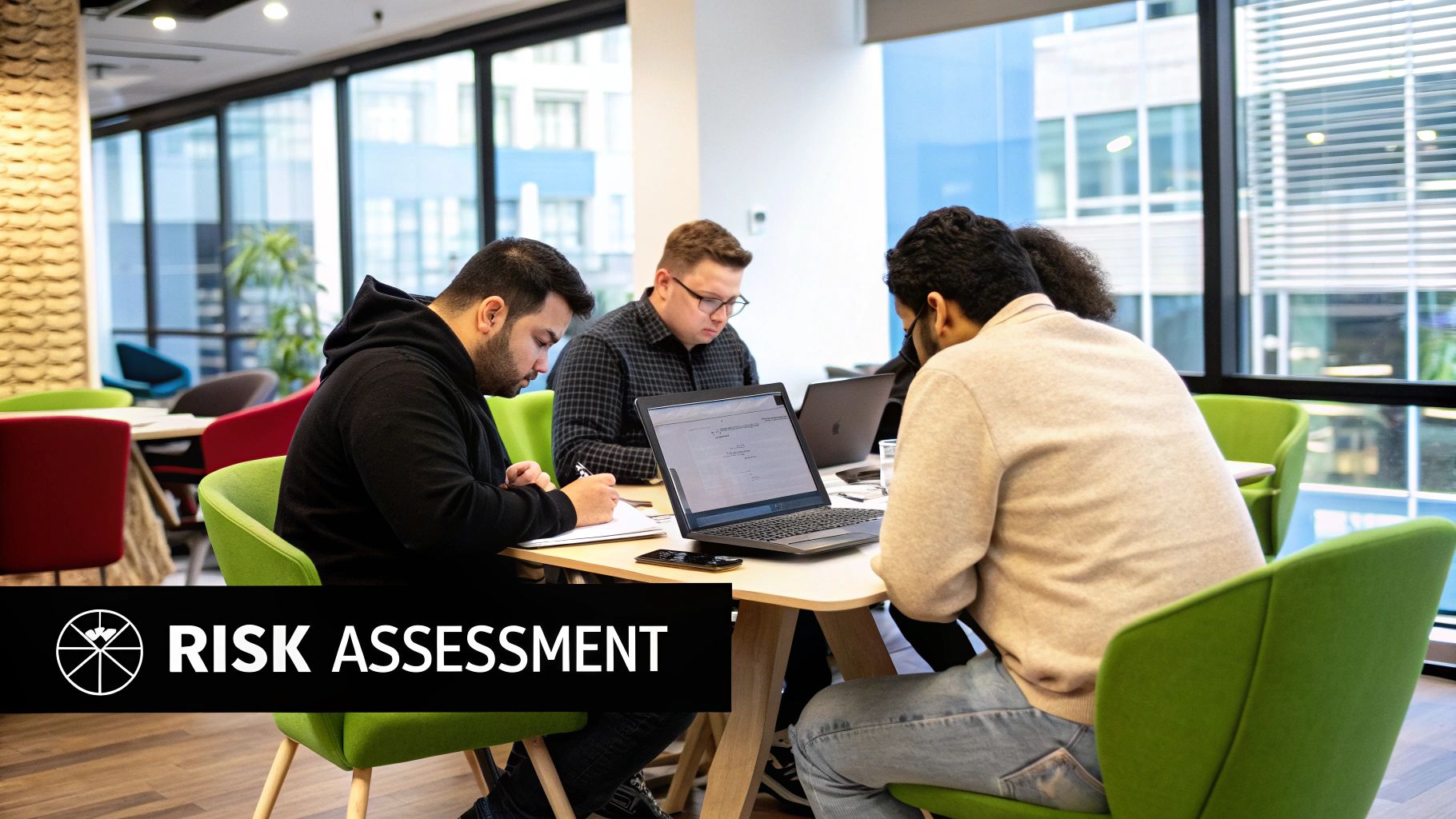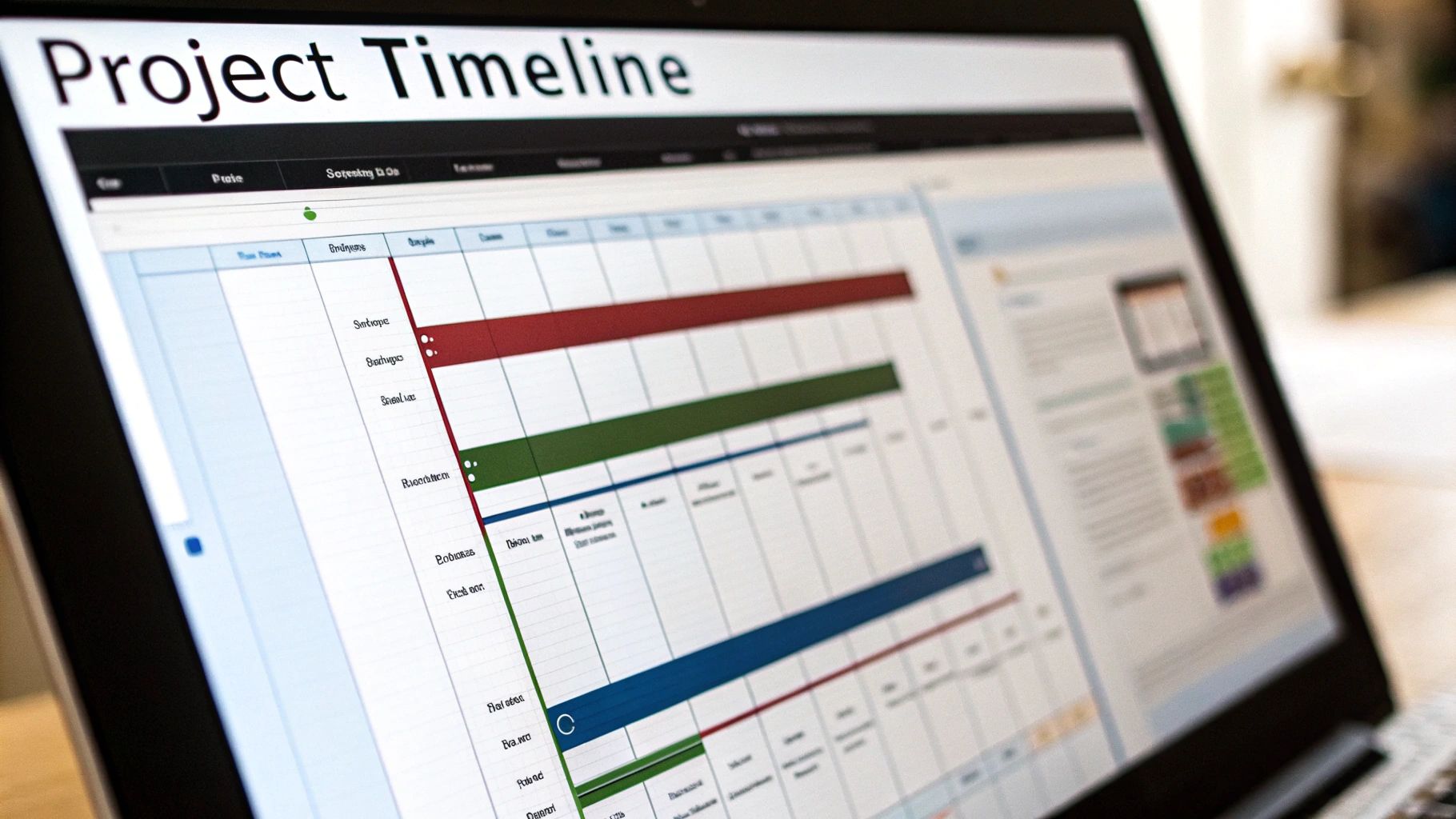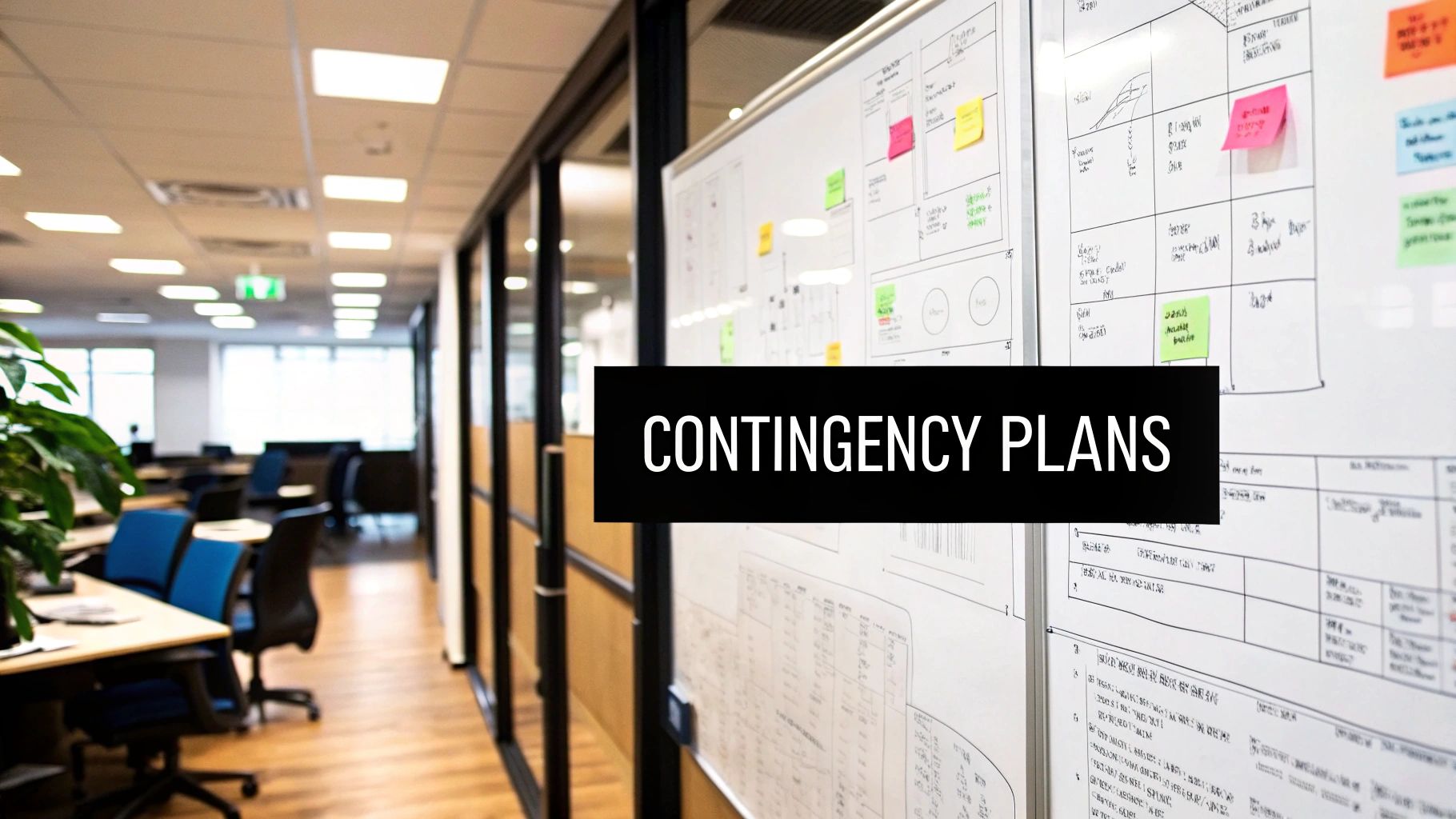Mastering Software Project Risk Management: A Strategic Guide for Modern Teams
Understanding the True Impact of Risk Management in Software Projects

Every software project faces risks - from technical hurdles and changing requirements to resource constraints. Managing these risks effectively isn't just good practice - it directly determines whether a project succeeds or fails. A thoughtful approach to risk management goes far beyond simple checklists to become a core part of project strategy.
Why Traditional Risk Management Often Falls Short
Many teams rely on basic risk registers that they rarely update. This reactive method leaves projects vulnerable since it can't keep pace with how quickly software development moves. For instance, if you identify a technology risk early on but the tech landscape shifts dramatically mid-project, your original risk plan may no longer help. Traditional approaches also struggle to mesh with agile development, where teams need to adjust course frequently based on new information.
The disconnect between static risk tracking and dynamic development often means teams end up managing risks that no longer matter while missing new threats. This highlights why risk management needs to evolve alongside the project rather than remaining fixed from the start.
The Power of Proactive Risk Management
Forward-thinking risk management spots potential issues early and puts plans in place before problems grow. Teams continuously identify, assess and address risks throughout the project. This allows quick responses when circumstances change. According to the Project Management Institute, robust risk management can reduce project issues by 80-90%. These impressive results show why proactive risk planning is essential, not optional. Learn more about effective approaches here.
Building a Competitive Advantage Through Risk Management
Leading software teams recognize that smart risk management creates real business advantages. When done well, it helps teams:
- Improve Project Predictability: Early risk identification leads to more accurate timelines and budgets
- Enhance Product Quality: Addressing technical risks proactively means fewer bugs and better performance
- Increase Team Efficiency: Less rework and fewer surprises let teams focus on delivering value
Moving beyond basic risk tracking to embrace proactive, integrated risk management helps teams handle software development challenges with confidence. This strategic approach turns risk management from a necessary task into a powerful tool for project success.
Building Your Risk Management Framework for Success

Every successful software project needs a well-structured approach to managing risks. A proper framework helps teams spot and handle potential issues before they become major problems. This means creating clear processes that work naturally with your development methods. For more insights, check out: How to master portfolio management.
Essential Components of an Effective Framework
A strong risk management framework needs several key elements working together. Here's what makes it work:
- Risk Identification: Start by finding all possible risks through team brainstorming, expert advice, and past project reviews. Look for everything from technical issues to resource limits.
- Risk Analysis: Examine each risk's potential impact and how likely it is to happen. Use both qualitative and quantitative methods to figure out which risks need the most attention.
- Risk Response Planning: Create specific plans for each risk you've found. You might avoid some risks, reduce others, transfer them elsewhere, or accept them. Make sure each risk has a clear action plan.
- Risk Monitoring and Control: Keep track of risks throughout your project. Watch how well your plans are working and look out for new risks. Update your risk list regularly to match what's happening in the project.
Conducting Engaging Risk Workshops
Risk workshops bring teams together to find and analyze potential problems. To make these sessions productive, focus on creating an environment where everyone feels comfortable sharing their thoughts.
- Clear Goals: Know exactly what you want to achieve in each workshop. What specific risks are you looking for? What do you want to accomplish?
- Mix of Perspectives: Include people from different parts of the project. This helps catch risks that one group might miss on their own.
- Organized Activities: Use specific methods like SWOT analysis or risk grouping to guide discussions and generate ideas.
- Next Steps: End each workshop with clear tasks. Make sure someone owns each risk and set deadlines for creating response plans.
Software projects always come with uncertainties. Good risk management helps teams spot problems early and deal with them effectively. Teams that follow these practices make better decisions about resources and project scope. Learn more about this topic here. Success comes from making risk management an active part of your project, not just a box to check. When teams embrace these methods, they handle challenges better and deliver more successful projects.
Harnessing Historical Data for Predictive Risk Management

Smart software project management goes beyond just dealing with current risks - it uses past data to see what's coming next. By analyzing previous project experiences, teams can spot potential issues early and take action before problems arise. This approach helps make risk assessment more accurate and reliable.
Building a Knowledge Base of Project Risks
The key to predicting future risks starts with good record-keeping. Teams need to carefully document past project challenges, their effects, and what solutions worked best. But this isn't just about filing away old reports - it's about creating a living resource that grows more valuable with each completed project.
Take a real example: When a project hits delays because of API integration problems, recording specifics about which API caused issues, how long delays lasted, and what fixed the problem gives future teams vital information. This helps them plan better when working with similar technologies and avoid the same pitfalls.
Identifying Patterns and Trends
With a solid collection of past project data, teams can start finding meaningful patterns. This information proves especially valuable for project planning, helping managers make better estimates about timelines and resource needs. Learn more about using historical data effectively here.
Past data often reveals interesting connections between specific project elements. For example, teams might notice that projects using certain programming languages tend to have more security issues during testing. This insight lets them add extra security testing time for these projects from the start.
Implementing Systems for Actionable Insights
Making past lessons useful requires good systems that put information at teams' fingertips. This could mean connecting risk management tools with project tracking software or creating clear visual dashboards showing key risk indicators.
But having access to data isn't enough - teams need clear processes for using these insights in their daily work. This might include reviewing relevant past projects during planning sessions or setting up alerts based on known risk patterns. When teams actively use historical data this way, they're much better prepared to spot and handle potential problems before they impact the project's success.
Implementing Risk Management Across Different Organization Types

Every organization needs to approach software project risk management differently based on their specific context and needs. Team size, company culture, and industry requirements all play crucial roles in determining the right approach. Recent studies show varying adoption rates - 27% of organizations consistently use risk management practices, 35% implement them occasionally, and only 3% never use them at all. For more details, check out these project management statistics.
Tailoring Risk Management to Startups
Small, fast-moving companies need quick and flexible risk management. Instead of long formal meetings, startups often benefit from brief daily check-ins to discuss potential issues. This approach helps teams stay nimble while still keeping risks in check. The focus stays on immediate, high-impact risks that could affect current development goals.
Adapting Risk Management for Enterprises
Larger organizations typically need more structure in their risk management approach. They often maintain detailed risk logs and assessment procedures across multiple teams and departments. Many enterprises use dedicated risk management software and assign specific team members to oversee the process. This helps maintain consistency when coordinating risk responses across complex organizational structures.
Navigating Risk Management in Different Industries
The nature of risk management varies significantly by industry. For example, healthcare software projects must prioritize patient safety and strict data privacy requirements. Gaming companies, on the other hand, focus more on user experience risks and market competition. Understanding these industry-specific needs helps teams build appropriate risk management strategies.
Evolving Your Risk Management Approach
As companies grow, their risk management practices need to mature. Small team processes often don't scale well to larger organizations. Regular reviews help ensure risk management keeps pace with company growth. This might mean gradually adding more formal procedures or adopting new tools. Building a strong risk-aware culture helps teams spot and address potential issues early, leading to more successful projects across the organization.
Mastering Risk Communication with Stakeholders
Clear, consistent communication about risks is essential for successful software project management. By turning routine updates into meaningful discussions, teams can foster understanding and drive collaborative solutions.
Crafting Clear Risk Messages
Different stakeholders need different information about risks. Development teams need specifics about technical challenges and roadblocks. Meanwhile, executives focus on business impacts like delays, costs, and reputation. When discussing issues like security vulnerabilities, explain technical details to developers but emphasize financial and legal implications to leadership.
Building Trust Through Transparency
Being open about risks, including difficult ones, creates trust and encourages collaboration. Rather than overwhelming stakeholders with every detail, focus on clearly presenting key risks, their potential impacts, and proposed solutions. This demonstrates the team is actively managing issues, which builds confidence in the project's success. For more guidance, see How to master stakeholder communications.
Making the Case for Resources
Clear communication about risk impacts is key for securing mitigation resources. For example, comparing the potential cost of a data breach to the investment needed for enhanced security measures helps justify allocating budget and staff. This proactive approach reduces negative outcomes while showing responsible project oversight.
Working Together on Solutions
Risk discussions work best as two-way conversations rather than one-sided presentations. Getting stakeholder input during solution brainstorming creates shared ownership and leads to better mitigation strategies. These collaborative sessions also strengthen team relationships and encourage proactive risk management.
Practical Communication Tips
- Show Data Visually: Use charts and graphs to make complex risk information easier to understand
- Keep Language Simple: Explain concepts clearly without technical jargon
- Focus on Actions: Provide specific next steps based on risk analysis
- Stay Consistent: Maintain regular risk updates through meetings and reports
- Listen and Respond: Address stakeholder questions and concerns promptly
By communicating effectively about risks, project teams can turn challenges into opportunities to collaborate and build stronger projects. This strategic approach ensures risks are not just managed but understood across the organization, supporting overall project success.
Measuring and Improving Your Risk Management Success
Creating real value through software project risk management requires moving beyond basic risk tracking. To demonstrate tangible results, you need concrete measurements, data-driven insights, and systematic improvement processes that show how risk management contributes to project success.
Establishing Meaningful KPIs
The foundation of measuring success starts with selecting the right performance indicators. Your metrics should directly connect to project objectives and provide clear evidence of how well your risk management is working. Key metrics to consider include:
- Number of risks identified early - While not the only measure, catching more risks in initial phases often indicates thorough assessment
- Percentage of risks successfully mitigated - Shows how well your response strategies work in practice
- Cost of risk mitigation activities - Helps track resource investment in risk management
- Impact of risks that occurred - Measures actual consequences when risks weren't prevented, informing future improvements
Quantifying the ROI of Risk Management
Getting stakeholder support requires showing the business value of risk management investments. Compare the costs of your risk management program against potential losses from unmanaged risks. For instance, weigh security measure expenses against possible financial damage from data breaches. You might find useful information in this article about How Hyathi is recognized as a top cybersecurity company.
Building a Continuous Improvement Cycle
Risk management needs ongoing refinement through regular reviews of processes, performance analysis, and targeted enhancements. This systematic approach helps your practices stay current with changing project conditions and grow more effective over time.
Utilizing Qualitative and Quantitative Indicators
While numbers like cost and schedule impacts matter, don't ignore qualitative feedback. Team input on risk processes, stakeholder satisfaction with communications, and improvements in project predictability provide important context. Using both types of data gives you a complete picture of your risk management effectiveness.
Benchmarking and Maturity Assessment
Compare your risk management approach against industry standards to spot improvement opportunities and gauge your maturity level. Regular assessments help identify gaps and create focused development plans. This keeps your practices current and impactful.
By implementing these measurement and improvement strategies, you can build risk management that delivers clear results and meaningfully supports project success. Want to enhance your software development with smart risk management? Visit Hyathi Technologies to learn how we can help you create reliable applications while effectively managing project risks.